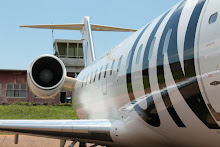Single Engine Night Currency
Over the past few weeks, I've been working on an Excel spreadsheet to use as a backup for my logbook. After completing it, I realized that I was close to losing night currency.
14CFR 61.57(b) states that a pilot must have at least 3 take offs and landings, to a full stop, in the last 90 days. The operations must be completed one hour after sunset and one hour before sunrise. A pilot cannot carry passengers at night unless this has been done. I don't carry passengers that often, but am a bit obsessive about remaining completely current.
I called Dana, who is always looking for an excuse to fly, and invited her to do an IFR flight from KIWA to Tucson International (KTUS). She accepted and we planned for Thursday night. We both needed to do 3 full stops to remain night current in single engine aircraft.
By the way, Dana just passed her CFII check-ride. Congrats. She is now CFI, CFII and a MEI.
We met at Gateway, checked out the aircraft and picked up the IFR clearance. We were on our way just 6 minutes behind schedule. I had filed for 7,000' and we were headed to our first navigational fix (TFD). We reached our cruising altitude ahead of schedule when wind started rushing in to the cockpit. Apparently, the upper door latch came loose! Dana was sitting right seat but, at 5'2" and maybe 120 lbs., isn't exactly a powerhouse. I tried pulling the door closed so she could latch it, but it was no use. We had to divert to Casa Grande. Luckily, it was right below us.
Albuquerque Center had a difficult time hearing my transmissions due to the wind noise in the cockpit. Luckily, a US Air flight could hear me and was kind enough to relay. We got on the ground in Casa Grande without incident. However, the landing light on this particular aircraft was so dim, that the lead off lines were barely visible. Also, the directional sign for the taxi way was burned out and there was no moon yet. A Cirrus was on final and I couldn't find the taxi way. Just before I was ready to advise the Cirrus to do a go-around, we found the taxi way. We taxied to parking and inspected the latch. Nothing was visibly wrong, other than it is a little difficult to engage.
Satisfied, we departed for Tucson. The ODP for Casa Grande requires a turn direct to the Stanfield VOR (TFD) where we then hold as we climbed to our assigned altitude. There were 5 planes holding for approaches, which means we would have had to enter the hold at 6,000'. There were also a few confused pilots in that hold so I got clearance from Albuquerque Center to turn and intercept V105 back towards Tucson. I had filed for the ILS 11L approach and Tucson had no problem giving it to us. We did have to do a 360 to make way for a Skywest CRJ and a Hawker. The ILS into Tucson is LONG. It was a nice landing and we taxied to the Executive Terminal, ready to find some dinner.
I have to say the staff at the Tucson Executive Terminal are about as nice as can be. They picked us up on the ramp and tied down the plane. Very nice. Tucson Airport is on the far South end of the city and there are few restaurants nearby. We asked for recommendations and they told us about a steakhouse that was a 5 minute cab ride away. We headed for Cattle Town and enjoyed a pretty decent steak dinner. I would have never stopped there if I was driving. It is across the street from two ratty looking trailer parks and looks like a big C&W nightclub/saloon from the outside. We were pleasantly surprised by the decent food and prices.
To stave off a food coma, we had to get up and walk around while we waited for the cab to pick us up. I'm usually indifferent about cabs, but the one we were in looked like a brand new Town Car. The owner/driver told me that it had over 300,000 miles on it. I was impressed how clean it looked and smelled. Yawn.
Dana took the leg back to Gateway. She struggled with taxiing due to the damn dim landing light, but we finally made it to the assigned departure runway. The flight back was smooth, easy and uneventful. We called Phoenix approach on the way back to Gateway and got the ILS 30C approach, then did some stop and go's. Just as we were finishing up, the right main started shuddering with braking at touchdown.
I decided to squawk the landing light and the brakes. I haven't seen what maintenance has done yet. I'm sure the maintenance response will be "landing light ops check-ok". That's not the point. I think it's a voltage issue, but I bet nothing was done about it. Some poor private student is in for a real treat when they do their night landings with that one. I have to admit that I'm a bit spoiled by having high-intensity Xenon landing & taxi lights on many of the planes I've been flying recently. However, the landing light didn't have enough voltage to put out even 15 watts of sickly looking yellow haze.
More on maintenance woes in the next post...

No comments:
Post a Comment